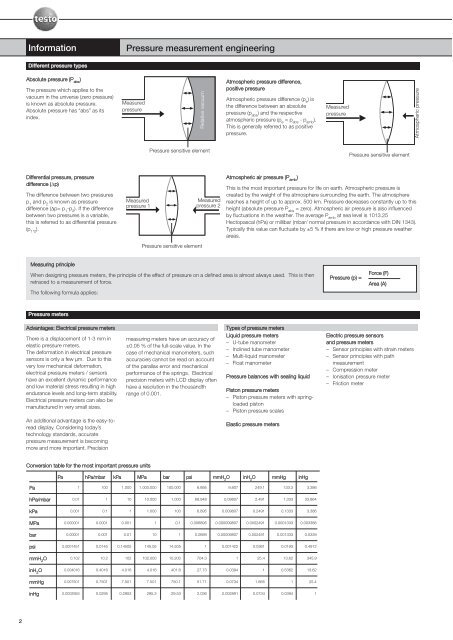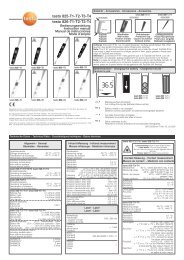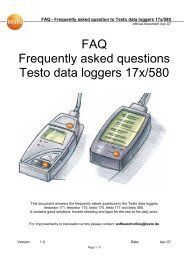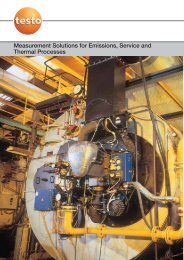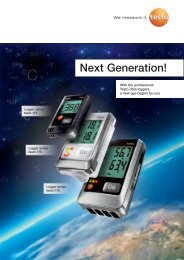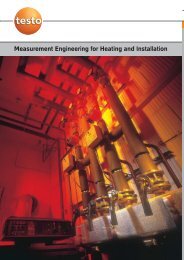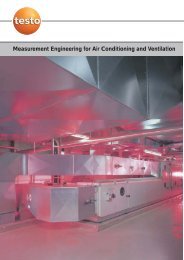Download - Testo
Download - Testo
Download - Testo
You also want an ePaper? Increase the reach of your titles
YUMPU automatically turns print PDFs into web optimized ePapers that Google loves.
2<br />
Information<br />
Different pressure types<br />
Absolute pressure (Pabs )<br />
The pressure which applies to the<br />
vacuum in the universe (zero pressure)<br />
is known as absolute pressure.<br />
Absolute pressure has “abs” as its<br />
index.<br />
Differential pressure, pressure<br />
difference (∆p)<br />
The difference between two pressures<br />
p1 and p2 is known as pressure<br />
difference (∆p= p1-p2 ). If the difference<br />
between two pressures is a variable,<br />
this is referred to as differential pressure<br />
(p1 , 2 ).<br />
Measured<br />
pressure<br />
Relative vacuum<br />
Pressure sensitive element<br />
Pressure sensitive element<br />
Measured<br />
pressure 2<br />
Atmospheric pressure difference,<br />
positive pressure<br />
Atmospheric pressure difference (pe ) is<br />
the difference between an absolute<br />
pressure (pabs ) and the respective<br />
atmospheric pressure (pe = pabs - pamb ).<br />
This is generally referred to as positive<br />
pressure.<br />
Measuring principle<br />
When designing pressure meters, the principle of the effect of pressure on a defined area is almost always used. This is then<br />
retraced to a measurement of force.<br />
The following formula applies:<br />
Pressure meters<br />
Advantages: Electrical pressure meters<br />
There is a displacement of 1-3 mm in<br />
elastic pressure meters.<br />
The deformation in electrical pressure<br />
sensors is only a few µm. Due to this<br />
very low mechanical deformation,<br />
electrical pressure meters / sensors<br />
have an excellent dynamic performance<br />
and low material stress resulting in high<br />
endurance levels and long-term stability.<br />
Electrical pressure meters can also be<br />
manufactured in very small sizes.<br />
An additional advantage is the easy-toread<br />
display. Considering today’s<br />
technology standards, accurate<br />
pressure measurement is becoming<br />
more and more important. Precision<br />
Measured<br />
pressure 1<br />
Conversion table for the most important pressure units<br />
Pa<br />
hPa/mbar<br />
kPa<br />
MPa<br />
bar<br />
psi<br />
mmH 2 O<br />
inH 2 O<br />
mmHg<br />
inHg<br />
Pa hPa/mbar<br />
1<br />
0.01<br />
0.001<br />
0.000001<br />
0.00001<br />
0.0001451<br />
0.102<br />
0.004016<br />
0.007501<br />
0.0002953<br />
100<br />
1<br />
0.1<br />
0.0001<br />
0.001<br />
0.0145<br />
10.2<br />
0.4016<br />
0.7501<br />
0.0295<br />
measuring meters have an accuracy of<br />
±0.05 % of the full-scale value. In the<br />
case of mechanical manometers, such<br />
accuracies cannot be read on account<br />
of the parallax error and mechanical<br />
performance of the springs. Electrical<br />
precision meters with LCD display often<br />
have a resolution in the thousandth<br />
range of 0.001.<br />
Measured<br />
pressure<br />
Pressure sensitive element<br />
Atmospheric air pressure (Pamb )<br />
This is the most important pressure for life on earth. Atmospheric pressure is<br />
created by the weight of the atmosphere surrounding the earth. The atmosphere<br />
reaches a height of up to approx. 500 km. Pressure decreases constantly up to this<br />
height (absolute pressure Pabs = zero). Atmospheric air pressure is also influenced<br />
by fluctuations in the weather. The average Pamb at sea level is 1013.25<br />
Hectopascal (hPa) or millibar (mbar/ normal pressure in accordance with DIN 1343).<br />
Typically this value can fluctuate by ±5 % if there are low or high pressure weather<br />
areas.<br />
Types of pressure meters<br />
Liquid pressure meters<br />
– U-tube manometer<br />
– Inclined tube manometer<br />
– Multi-liquid manometer<br />
– Float manometer<br />
Pressure balances with sealing liquid<br />
Piston pressure meters<br />
– Piston pressure meters with springloaded<br />
piston<br />
– Piston pressure scales<br />
Elastic pressure meters<br />
kPa MPa bar psi mmH 2 O inH 2 O mmHg inHg<br />
1.000<br />
10<br />
1<br />
0.001<br />
0.01<br />
0.14505<br />
102<br />
4.016<br />
7.501<br />
0.2953<br />
Pressure measurement engineering<br />
1.000.000<br />
10.000<br />
1.000<br />
1<br />
10<br />
145.05<br />
102.000<br />
4.016<br />
7.501<br />
295.3<br />
100.000<br />
1.000<br />
100<br />
0.1<br />
1<br />
14.505<br />
10.200<br />
401.6<br />
750.1<br />
29.53<br />
6.895<br />
68.948<br />
6.895<br />
0.006895<br />
0.0689<br />
1<br />
704.3<br />
27.73<br />
51.71<br />
2.036<br />
9.807<br />
0.09807<br />
0.009807<br />
0.000009807<br />
0.00009807<br />
0.001422<br />
1<br />
0.0394<br />
0.0734<br />
0.002891<br />
249.1<br />
2.491<br />
0.2491<br />
0.0002491<br />
0.002491<br />
0.0361<br />
25.4<br />
1<br />
1.865<br />
0.0734<br />
133.3<br />
1.333<br />
0.1333<br />
0.0001333<br />
0.001333<br />
0.0193<br />
13.62<br />
0.5362<br />
1<br />
0.0394<br />
3.386<br />
33.864<br />
3.386<br />
0.003386<br />
0.0339<br />
0.4912<br />
345.9<br />
13.62<br />
25.4<br />
1<br />
Pressure (p) =<br />
Force (F)<br />
Area (A)<br />
Electric pressure sensors<br />
and pressure meters<br />
– Sensor principles with strain meters<br />
– Sensor principles with path<br />
measurement<br />
– Compression meter<br />
– Ionisation pressure meter<br />
– Friction meter<br />
Atmospheric pressure


